To build lean muscle as a woman, focus on these essential workouts: squats, deadlifts, push-ups, lunges, rows, glute bridges, shoulder press, pull-ups, and kettlebell swings. These exercises target major muscle groups efficiently, promoting overall strength and muscle development. Incorporate a mix of compound movements and isolation exercises to maximize your results. Start with lighter weights to perfect your form, then gradually increase the load as you become stronger. Aim for 3-4 sets of 8-12 reps for each exercise, adjusting based on your fitness level. Remember to maintain proper form and engage your core throughout each movement. Exploring these exercises in depth will reveal their unique benefits and variations.
Core Insight
- Compound exercises like squats and deadlifts target multiple muscle groups efficiently for building lean muscle.
- Incorporate progressive overload by gradually increasing weights or reps to continually challenge muscles.
- Include a mix of strength training and high-intensity interval training (HIIT) for optimal muscle growth and fat loss.
- Focus on proper form and technique to maximize muscle engagement and prevent injuries during workouts.
- Ensure adequate protein intake and post-workout nutrition to support muscle recovery and growth.
Squats
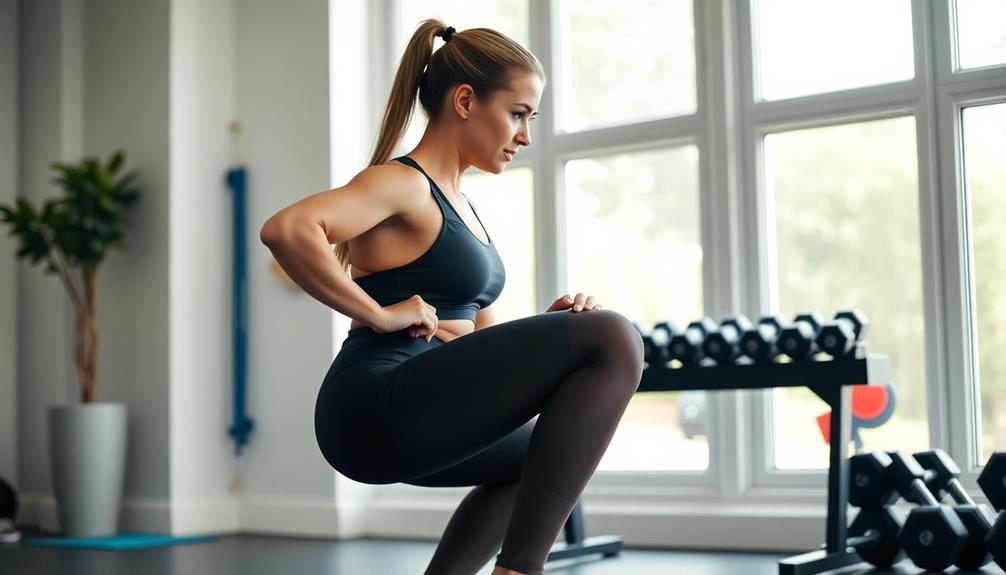
Squats are one of the best lower body exercises for women. They work several muscles, like your quads, hamstrings, glutes, and calves. To do a basic squat:
- Stand with your feet shoulder-width apart.
- Lower your body like you're sitting back in a chair. Keep your chest up and weight on your heels.
- As you go down, don't let your knees go past your toes.
- Try to get your thighs parallel to the ground.
- Push through your heels to stand back up.
Aim for 3-4 sets of 8-12 reps, based on your fitness level. Keep good form to get the most benefits and avoid injury. Do squats 2-3 times a week for best results.
To help your muscles recover, think about taking BCAA supplements after your workout. They can reduce soreness and help you recover faster.
Deadlifts
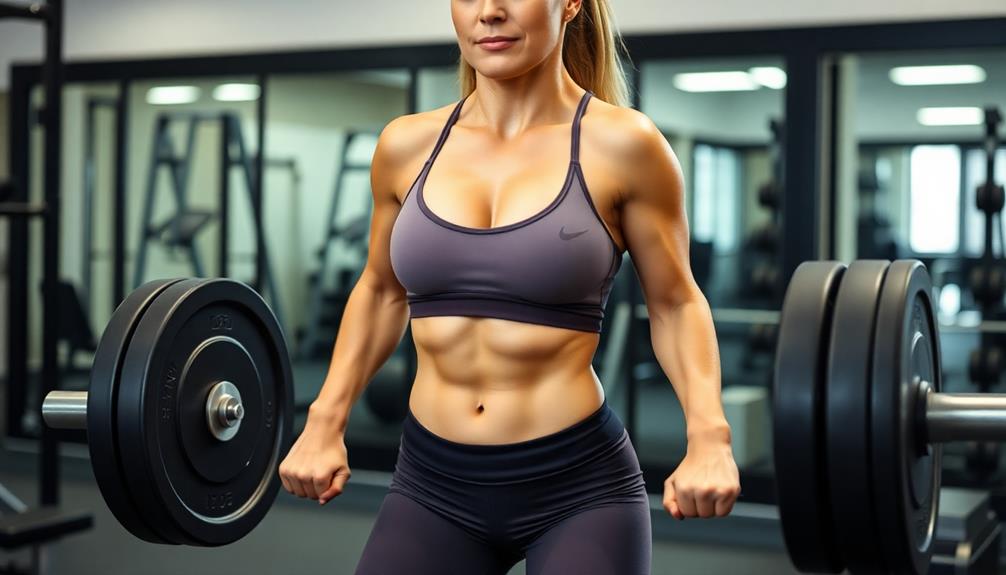
Deadlifts are a great exercise to strengthen your glutes, hamstrings, and lower back. They work well with squats to build overall lower body strength. To stay safe and comfortable, think about wearing compression sleeves on your calves or knees during deadlifts. Here's how to do a deadlift:
- Stand with your feet hip-width apart, toes under the barbell.
- Bend your hips and knees, gripping the bar with your hands just outside your legs.
- Keep your back straight and chest up as you lift the bar.
- Push through your heels as you straighten your hips and knees.
- Stand up tall and squeeze your glutes at the top.
- Lower the bar back down in a controlled way.
Begin with lighter weights to get your form right before using heavier ones. Deadlifts aren't only for serious weightlifters. They're a great exercise for women who want to build lean muscle and get stronger overall.
Push-Ups
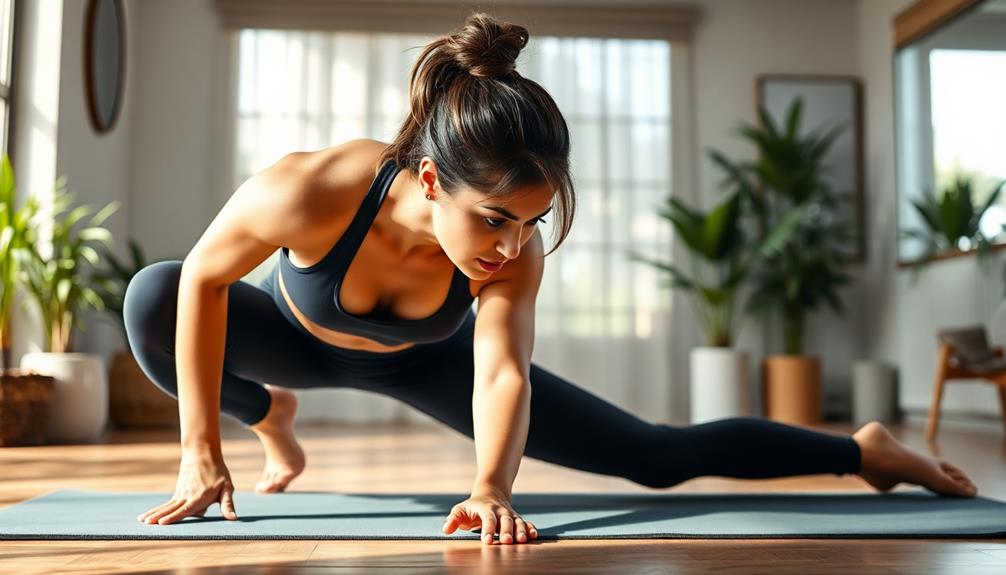
Push-ups are a great exercise for your upper body. They work your chest, shoulders, and arms. You don't need any equipment, so you can do them anywhere. Here's how to do a push-up the right way:
- Get into a plank position with your hands a bit wider than your shoulders.
- Keep your body in a straight line and tighten your core.
- Lower yourself until your chest almost touches the ground.
- Push yourself back up to where you started.
Using a foam roller before or after push-ups can help your muscles recover and make you more flexible. This can help you do push-ups better.
If push-ups are new for you, try easier versions first:
- Wall push-ups: Stand facing a wall and push against it.
- Knee push-ups: Keep your knees on the ground instead of your toes.
As you get stronger, switch to regular push-ups. Try to do 3 sets of 8-12 push-ups. Slowly increase the number as you get better. Do push-ups 2-3 times a week for the best results.
Lunges
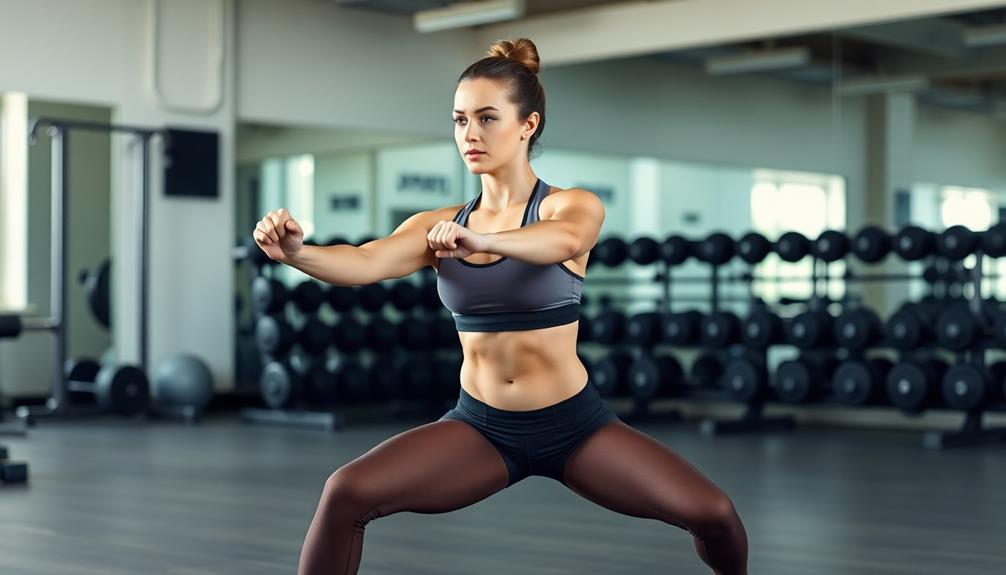
Lunges are a great exercise for strengthening your legs and glutes. They can be done at home or at the gym. Lunges help improve flexibility in your lower body.
Here's how to do a basic lunge:
- Stand with your feet hip-width apart
- Step forward with one leg
- Lower your hips until both knees are bent at 90-degree angles
- Keep your front knee above your ankle
- Push back to the starting position
As you get better, try different types of lunges like reverse lunges, side lunges, or walking lunges. These work different muscles and keep your routine interesting. Focus on good form, keeping your core tight and back straight. Start with 2-3 sets of 10-12 lunges on each leg. Gradually do more as you get stronger.
Rows

Rows are a great exercise to build strength in your back and arms. You can do them with dumbbells, a barbell, or resistance bands. Here's how to do a basic row:
- Stand with your feet apart
- Bend your knees a bit and bend at the hips
- Keep your back straight
- Pull the weight to your ribcage, squeezing your shoulder blades
Make sure to keep good form when you row. This will help you get the most out of the exercise and avoid getting hurt. Keep your elbows close to your body and don't swing or use momentum. After your workout, try foam rolling to help your muscles recover and be more flexible. This can make you less sore and help you perform better.
Start with lighter weights and slowly increase as you get stronger. Do rows 2-3 times a week for best results. Remember to breathe while you exercise, breathing out as you pull the weight up.
Planks
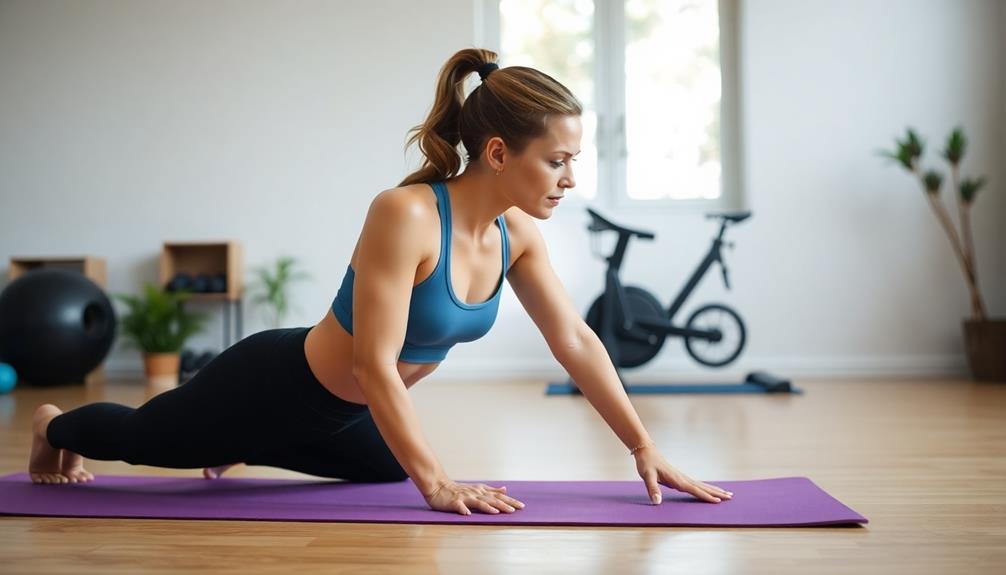
Planks are a great way to strengthen your core. To do a basic plank, lie face down and prop yourself up on your forearms, keeping your elbows under your shoulders. Lift your body, balancing on your forearms and toes. Keep your body straight from head to heels, engaging your core. Hold for 30 seconds to a minute, or as long as you can with good form. As you get better, hold the plank longer or try different types like side planks. Remember to breathe evenly. A cooling towel can help you stay comfortable during intense planks. Planks make your core stronger, improve your posture, and reduce back pain.
Glute Bridges
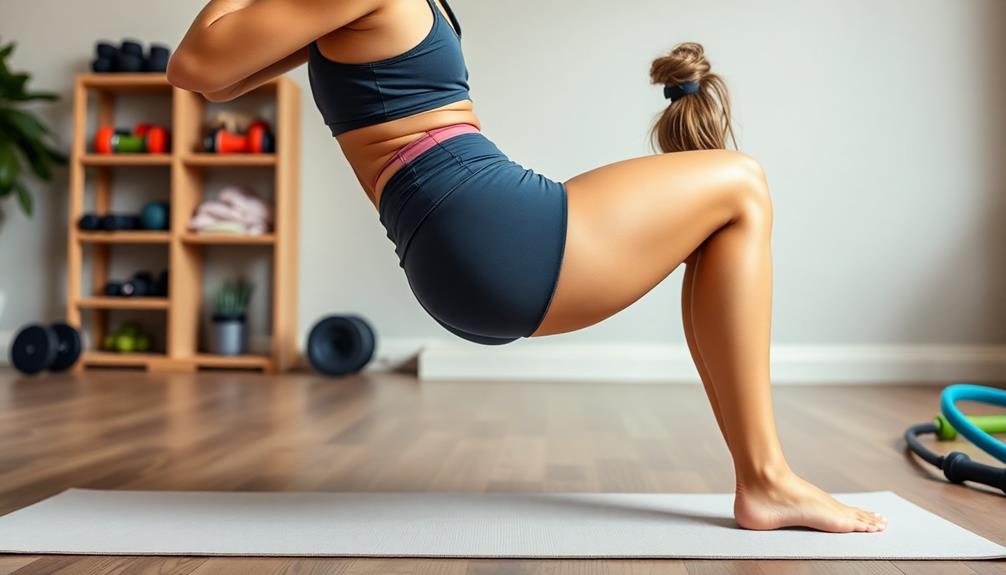
Glute bridges are a great exercise for targeting your glutes, hamstrings, and core. They help strengthen your backside while improving hip mobility and stability. To do a glute bridge, lie on your back with knees bent and feet flat. Lift your hips, squeezing your glutes at the top, then lower back down. For an extra challenge, try putting a roller under your feet during the exercise. This works your stability and core even more.
Include glute bridges in your workout to:
- Make your lower body stronger
- Improve posture and reduce back pain
- Perform better in sports and activities
- Shape and firm your glutes
Start with regular bridges, then try harder variations like single-leg bridges or using weights or bands. Do 3 sets of 12-15 reps, paying attention to good form and muscle engagement the whole time.
Shoulder Press
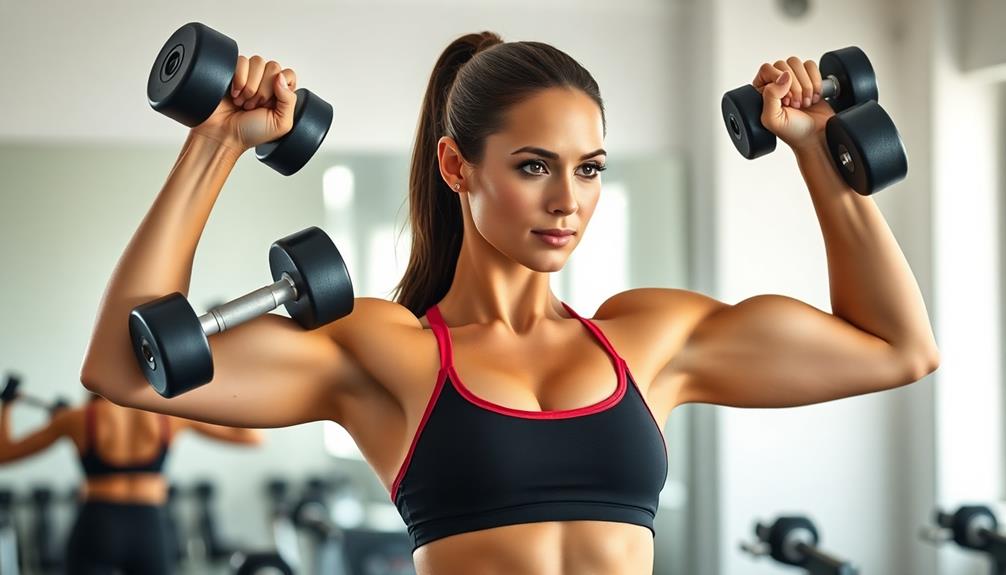
The shoulder press is a great exercise to strengthen your shoulders, triceps, and upper chest. Adjustable dumbbells work well for this exercise. They let you increase the weight as you get stronger. You can use them at home or at the gym.
Here's how to do a shoulder press:
- Stand with your feet shoulder-width apart.
- Hold the dumbbells at shoulder height with your palms facing forward.
- Keep your abs tight and your back straight.
- Breathe out as you press the weights overhead until your arms are straight.
- Pause for a moment at the top.
- Breathe in as you slowly lower the weights back to the starting position.
If you're new to this exercise, start with lighter weights. Focus on using the correct form. As you get stronger, slowly increase the weight. Try to do 3 sets of 8-12 reps. Rest for 60-90 seconds between sets. Do shoulder presses 2-3 times a week for the best results.
Pull-Ups

Pull-ups are one of the hardest upper body exercises. They're great for making your back, arms, and core stronger. If you've never done pull-ups before, don't worry – you can work your way up to them. Start with assisted pull-ups using a band or machine, and slowly use less help as you get stronger. To help your muscles even more, think about using a foam roller, which can make you more flexible and help your muscles recover.
Here's why you should do pull-ups:
- They work a lot of muscles at once
- They make your upper body stronger and improve your posture
- They're really good at building muscle
- You can change them to fit your fitness level
Make sure you do them the right way: keep your core tight, don't swing, and focus on smooth movements. If you keep practicing, you'll be doing pull-ups like a pro in no time and enjoying all the benefits they bring.
Kettlebell Swings
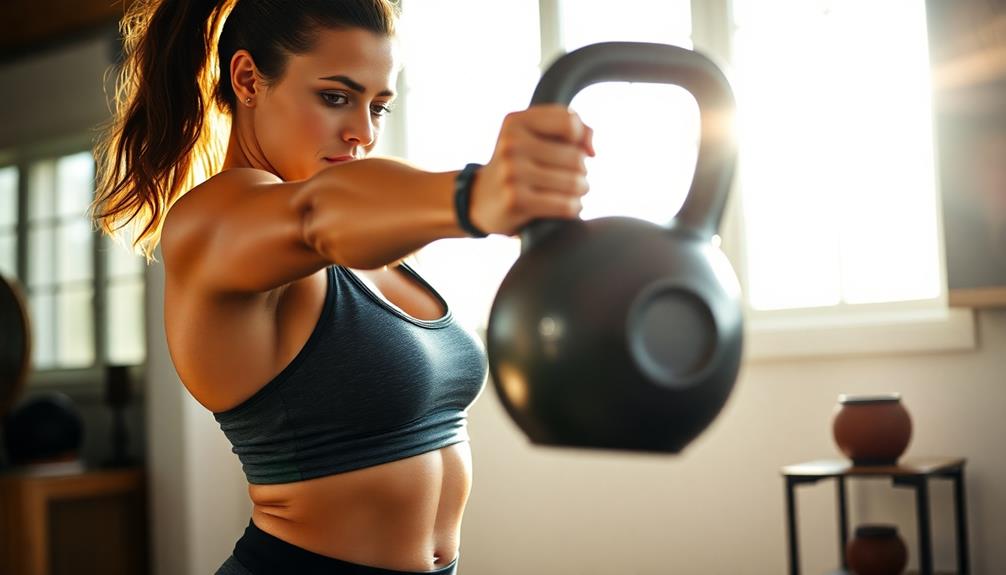
Kettlebell swings work your whole body, not just one part. They help you build muscle, get stronger, and improve your cardio. Here's how to do them right:
- Stand with your feet apart, holding the kettlebell in front of you with both hands.
- Bend forward at the hips and swing the kettlebell between your legs.
- Push your hips forward and swing the kettlebell up to your chest.
- Lower it back down in a controlled way. Repeat.
Kettlebell swings are great because:
| Body Part | What It Does | How Much |
|---|---|---|
| Butt | Makes it stronger | A lot |
| Abs | Keeps you stable | Medium |
| Shoulders | Shapes them | Medium |
| Heart | Makes it work harder | A lot |
Start with a lighter kettlebell so you can get the form right. Try doing 3 sets of 12-15 reps. As you get better, you can use a heavier kettlebell and do more reps.
Frequently Asked Questions
How Often Should I Perform These Workouts for Optimal Muscle Gain?
You should perform these workouts 3-4 times per week for best muscle gain. Allow at least one day of rest between sessions. Don't overtrain; your muscles need time to recover and grow. Consistency is key to seeing results.
What's the Ideal Protein Intake for Women Looking to Build Lean Muscle?
You'll need about 1.6-2.2 grams of protein per kilogram of body weight daily for best muscle gain. Focus on lean sources like chicken, fish, and legumes. Don't forget to spread your intake throughout the day.
Can I Do These Exercises While Pregnant or Postpartum?
You should consult your doctor before starting any exercise routine while pregnant or postpartum. They'll guide you on safe activities for your specific situation. Generally, low-impact exercises and modified strength training can be beneficial, but always prioritize your safety.
How Long Should I Rest Between Sets for Maximum Muscle Growth?
You'll want to rest 60-90 seconds between sets for best muscle growth. If you're doing compound exercises, you might need up to 2-3 minutes. Listen to your body and adjust as needed for your workout intensity.
Are There Any Supplements Specifically Beneficial for Women Building Lean Muscle?
You'll benefit from protein powder, creatine, and BCAAs for lean muscle growth. Consider omega-3s for inflammation reduction and vitamin D for bone health. Always consult a healthcare professional before starting any new supplement regimen.

